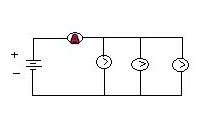Light bulbs
 Three similar light bulbs are connected to a constant-voltage d.c. supply as shown in the diagram. Each bulb operates at normal brightness and the ammeter (of negligible resistance) registers a study current.
The filament of one bulb breaks. What happens to the ammeter reading and to the brightness of the remaining bulbs?
Three similar light bulbs are connected to a constant-voltage d.c. supply as shown in the diagram. Each bulb operates at normal brightness and the ammeter (of negligible resistance) registers a study current.
The filament of one bulb breaks. What happens to the ammeter reading and to the brightness of the remaining bulbs?
Ammeter reading vs Bulb brightness
This section requires Javascript.
You are seeing this because something didn't load right. We suggest you, (a) try
refreshing the page, (b) enabling javascript if it is disabled on your browser and,
finally, (c)
loading the
non-javascript version of this page
. We're sorry about the hassle.
As the bulbs are in parallel, when a bulb fuses, the net resistance increases. so, current decreases. Moreover, the brightness remains unchanged because they are connected in parallel. Correct me if I am wrong.